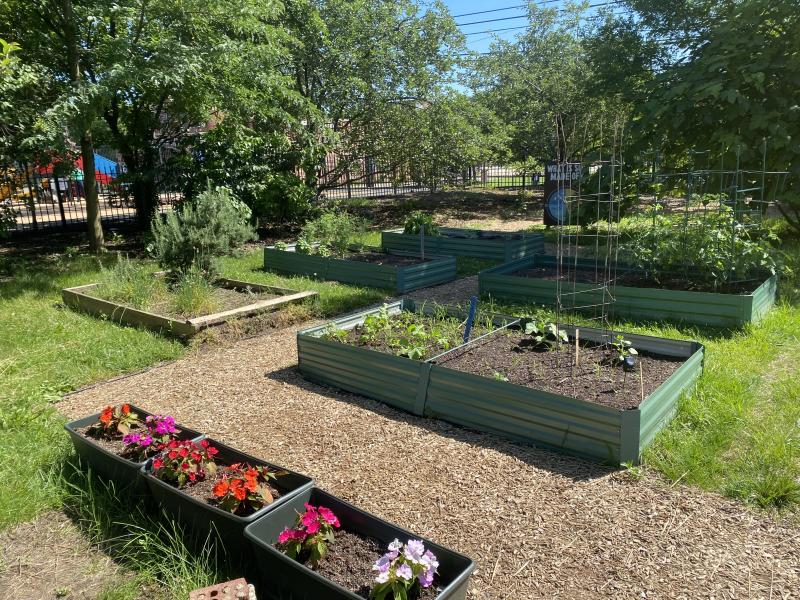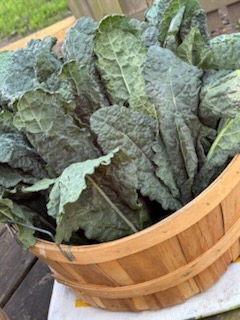
“The great garden of Anacostia is becoming a beacon for Anacostia residents. Lush and plentiful, it attracts the attention of anyone that walks by. Whether it’s the bushels of lavender or ripe pumpkins, you feel compelled to either stare in awe or purchase some for yourself. All of the produce grown and harvested in the garden is from students and community members within Thurgood Marshall Academy, a product of collaborative volunteer efforts.” - Thurgood Marshall Academy, 9-12
This section includes guidance on starting a new school garden program. Depending on the scope of the project, this process may take months to complete and involves planning and coordination among the school community (teachers, staff, students, parents), neighbors, local businesses, and community members.
Steps for Establishing a New School Garden
It may be necessary to adjust the order of the steps depending on the unique circumstances of the school or community. Below are the recommended action steps for establishing a new school garden:
- Get Educated: The first step is to have a basic understanding of school gardens including why school gardens are important, what’s the impact of school gardens on students, and where to find resources that will support your school garden.
- Take Action:
- Register for the OSSE School Garden 101 Training, which is available to watch at any time and provides an overview of the resources available and guidance on establishing a school garden program. Email Sam Ullery at [email protected] to register.
- Take Action:
- Conduct a Feasibility Study: The second step is to determine if there is interest and support within the school community (especially the teachers, staff, and administration).
- Take Action:
- Survey the school community and other key stakeholders to understand the level of interest and support as well as potential barriers to start a new school garden using the Tips and Tools for Conducting a Feasibility Study for a New School Garden.
- Take Action:
- Create a Project Plan: This third step is to lay out a roadmap for success so that all stakeholders have a shared understanding of the project. A project plan increases the likelihood that the garden successes and helps to align the garden program with existing school priorities (such as academic achievement, student satisfaction, and strengthening the school culture).
- Take Action:
- Draft a project plan using the Resources to help with Creating a Project Plan for School Garden Programs.
- Create a list of activities necessary to manage the garden. Use the Typical Activities to Run a School Garden for ideas.
- Identify a staffing model and write job descriptions for the roles using the School Garden Staff Models and Job Descriptions.
- Present the plan to your school administration.
- Take Action:
- Cultivate partnerships: Thriving school gardens are three-times more likely to have community partners. In DC, there are many organizations that seek to partner with schools to support garden-based teaching and learning. These organizations have expertise in administering school garden programs including curriculum, staffing, and garden design/maintenance.
- Take Action:
- Attend DC Teachers’ Night where you can meet with dozens of organizations that support gardenbased teaching in schools.
- Find partners by searching the Outdoor Learning ArcGIS Map. This map intends to help visualize where outdoor learning is taking place in the District, types of outdoor learning features that may be present in schools, and environmental education partners.
- Learn about how schools from across the country are building relationships for program success.
- Invite community support by creating easy opportunities and establishing clear roles to encourage and help community members become involved and invested in the garden program. This is especially important during school breaks. Consider ways others can be champions, partners, or supporters by sharing their time, expertise and resources.
- Formalize the partnership through a MOU, use the examples of MOUs between schools and communitybased organizations as a guide.
- Take Action:
- Establish an advisory committee: Thriving school garden are four-times more likely to have an advisory committee Ideally, this committee should consist of all stakeholders in the garden program including students, staff, parents, teachers, community members, school nutrition staff, and administrators. Some schools leverage their Local Wellness Policy, which requires schools to create plans for how they will provide community members with the opportunity to participate in the local wellness policy process as well as serve on the committee. This committee can be tasked with supporting the school garden program. Still, other schools have established separate school garden committees. Either way, research shows that a school garden committee is an important step toward the success of the school garden program.
- Take Action:
- Review your school’s Local Wellness Policy to see what the process is for getting involved. Local Wellness Policies must be made available to the public on the school’s website.
- Using the results of the survey that was conducted as a part of the feasibility study, identify school staff that may be interested in being a part of the advisory committee.
- Set a meeting date and time that works for most people and share the agenda ahead of time.
- Take Action:
- Decide on the garden location: For many, this is an enticing early step in the process of establishing a school garden; however, it is strongly recommended to hold off. A lack of space should not prevent a garden program from taking place. A school garden can provide meaningful learning and be successful at any size. The garden can even be grown indoors. Starting with less than 200 square feet of growing space is recommended, allowing for the garden space to expand as needed. Larger gardens will require significantly more maintenance and create unique classroom management challenges. Leave designing and building the garden for later in the process (see step number 8).
- Take Action:
- Review the Outdoor Learning Materials Checklist and the Design Guidelines for Outdoor Classrooms and School Gardens for details on identifying the garden location and design elements.
- Explore examples of other District school garden programs that can serve to inspire. Consider showing OSSE’s District School Garden Photos as inspiration.
- Take Action:
- Secure funds: Funding has a significant influence on how well integrated a garden program is within a school. Securing funds to establish the garden may take several months or longer; however, with an advisory committee, committee partners, a project plan, and a feasibility study you are able to make a strong case for funding.
- Take Action:
- Review the District School Garden Funding Guidance and the Outdoor Learning Funding Resources documents for more information on funding sources and strategies to sustain funding.
- Learn about models for Funding School Garden Work across the country
- Explore Finding School Garden Supplies and Budgeting Resources, which includes a budgeting spreadsheet and a donation request template.
- Take Action:
- Design and build the school garden: This is the step where it all comes together. Designing and building a school garden can be kept simple, but certain aspects require specific technical skills (such as carpentry, landscape design, and horticulture). The design decision (location, size, and materials) can make the difference between a garden space that is expensive and difficult to maintain, and one that is sustainable and welcoming. This step offers a unique opportunity to engage stakeholders and to generate excitement about the school garden. Include as many people as possible in the garden build, make it fun and easy for parents, students, and school staff to help with the build. Below are some tips for designing and building a school garden while also generating support:
- Take Action:
- Survey student interests: This step is often overlooked; however, this is anopportunity to include students, who will be the primary users of the garden, in as many decisions as possible starting with the design process. One way to start the conversation is through a design charrette activity. For more information, review Hosting Garden Design Charrettes by Cornell’s Garden-Based Learning Program.
- Document the progress: Take photos of the garden space before breaking ground. This will serve as the “before” photo to compare with the “after” photo of the completed project. Continue to document the growth of the garden using photos.
- Create a drawing with dimensions that can be used throughout the design process. Measure the garden space including the boundaries of the garden, and the location of any permanent elements such as large trees and sidewalks. These maps can be used as base maps to overlay student drawings as well as the final garden design. The DC Office of Planning has Maps and Data from the Office of Planning to assist with a dimensional drawing of the garden. The Food and Agricultural Organization of the United Nations also has a guide to mapping your school garden with students which is also a great example of how a school garden can be used for crosscurricular activities such as math, science and nutrition.
- Source materials: Refer to the School Garden Safety Checklist and the Common Maintenance Tasks for a DC School Garden. Test the existing soil for heavy metals including arsenic and lead before breaking ground, and once every three years or when the new growing medium (soil, compost, mulch) is added from an untested source. OSSE recommends these soil testing facilities which can provide recommendations for soil remediation based on the test results. For additional safety considerations review step 5 School Garden Safety in the Managing an Existing School Garden Programs section.
- Review the Design Guidelines for Outdoor Classrooms and School Gardens document for guidance on locating a school garden on school grounds, materials, dimensions of planting beds, and accessibility.
- Here is an example of how a school garden can be designed in phases:
- Phase 1: Purchase and stage all materials on-site, prepare items and materials.
- Phase 2: Implement a garden workday with the school community and volunteer groups to build the garden.
- Phase 3: Complete items that were not completed during the workday. This can be completed by the school garden staff, a class, or may require an additional workday.
- Phase 4: Celebrate the completion of the garden space with all stakeholders. Communicate the planned impact of the garden and how others can be involved.
- Take Action:
- Celebrate: This final step is often overlooked, but it's important to formally transition from the building of a school garden to the implementation of the garden program. A celebration can take many forms and should be viewed as an opportunity to set the precedent for subsequent celebrations that reinforce the school’s culture. Be sure to include all stakeholders including students, parents, teachers, community members, and school staff.
- Take Action:
- Create and share thank you cards or small gifts from the garden to everyone that helped to build the garden.
- Host an “open garden” time where staff can drop in to see the garden space and participate in studentled tours of the garden.
- Create a simple platform like a website or social media account where images and accounts of the garden can be shared.
- Take Action:
Additional guidance documents for starting a school garden:
- National Farm to School Network Starting and Maintaining School Gardens
- KidsGardening Starting a School Garden Program
- WholeKids Foundation School Garden Startup Guide

“The garden is special because it is a place to come get food. Our market on Friday sells nice yummy vegetables and fruits. My mom came and bought onions and I got a sticker! We would also come and take some food from the garden during recess. The strawberries look so juicy! We like to get the darkest red ones because they’re sweet. The little ones are too sour. One time my mom came in and took some okra.”- Barnard Elementary School Student


